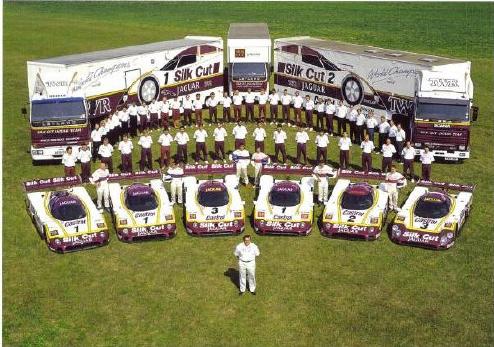

The 1980's saw the return to racing glory for Jaguar. From the great efforts of Group 44 in the early part of the decade, TWR built on that foundation to bring Jaguar to the winners podium again at both Daytona and Le Mans in 1988 and 1990. They would continue to see great achievement in World Sports Car (IMSA and Group C) in the 80's and 90's, becoming World Sports Car Champions in 1987, 88, & 90. As they were in the mid-50's, it was a time when Jaguar was again on top of the racing world.
| 1984 XJR-5: Lee Dykstra penned the great lines of the XJR-5. With Jaguar support, Group 44 developed the car for IMSA racing in the USA, followed by the modified and further developed cars which ran at Le Mans in 1984 & 85. Powered by 6.0L, stock block, mid-engine V12, ultimately producing 650 bhp, this engine would be the basis for the great Jaguar prototype cars and Le Mans winners to come. Brian Redman and Doc Bundy drove this car (Ch#006)to the win at the Miami 3 Hr. Model by STARTER 1/43 |
1984 XJR-5: Successful SCCA racer Bob Tullius and his Group 44 team brought Jaguar back to the Sarthe circuit after a twenty year absence in 1984. The XJR-5 proved to be a very competitive car, with top speeds comparable to the Porsche and Lancia competition. Car #40 (Chassis 008) driven by John Watson, Tony Adamowicz & Claude Ballot-Lena retired due to an accident as a result of a flat tire. Click here for an interesting website on Tony Adamowicz's career. Model by MILESTONE MINIATURES 1/43 |
1984 XJR-5: The second team car at Le Mans in 1984, driven by Brian Redman, Doc Bundy and Bob Tullius in the GTP class. Powered by the 6.0L SOHC V12 Jaguar engine, the XJR-5 produced 650 bhp and had a top speed of 217 mph. The car retired after 21 hrs and being in 6th place, due to gearbox troubles. In my opinion, this is one, if not the best looking of the Group 6/GTP cars of that era. Model by Bizarre 1/43 |
1984 XJR-5: One of 30 factory built cars by AMR in 1984. Model by AMR 1/43 |
See our Group 44, Inc. page at: CLICK HERE
THE TWR ERA BEGINS
| 1988 XJR-9LM: Model by HPI 1/43 |
1988 XJR-9LM: Model by HPI 1/43 |
1988 XJR-9LM: Model by HPI 1/43 |
| 1988 XJR-9D Model by CORGI 1/43 |
1988 XJR-9D Model by ONYX 1/43 |
1988 XJR-9D Model by SCALEXTRIC 1/32 |
| 1988 XJR-9D: 1988 Daytona 24 hr. winner Model by TOMY 1/64 |
1988 XJR-9D: "The Final Pit Stop" diorama of the winning Daytona car in 1988. Model by SPARK 1/43, Diorama by OLD IRISH |
THE SIGNATURE PROJECT & RACING DIORAMAS
THE TRIPLE CROWN OF ENDURANCE RACES:
THE 24 HOURS of LE MANS 1923-2019
THE 12 Hours of SEBRING WINNERS
THE 24 HOURS of DAYTONA WINNERS
GREAT AUTOMOTIVE MAKES:
ABARTH
ALFA ROMEO
ASTON MARTIN
AUDI
AUSTIN HEALEY & HEALEY
BMW
CHAPARRAL
CHEVROLET POWER
DATSUN/NISSAN
FORD POWER - GT40's, MUSTANGS, MIRAGE & MORE
LANCIA
LOLA SPORTS CARS
LOTUS
McLAREN
MASERATI
MERCEDES BENZ
MG CARS
SHELBY'S COBRAS, DAYTONAS, FORD GT40's & MUSTANGS
TOYOTA
TRIUMPH
RACING, RALLYE, SPORTS, GT & CLASSIC CARS
RACING SPORTS, GT & PROTOTYPE CARS 1945 to 1959
RACING SPORTS, GT & PROTOTYPE CARS 1960 to 1969
RACING SPORTS, GT & PROTOTYPE CARS 1970 to 1979
RACING SPORTS, GT & PROTOTYPE CARS 1980 to Current
LAND SPEED RECORD CARS
SPORTS. GT & TOURING CARS
VETERAN, CLASSIC & SPECIAL INTEREST CARS
DRIVER TRIBUTES:
THE OLD IRISH RACING HALL OF FAME
JUAN MANUEL FANGIO TRIBUTE
STIRLING MOSS TRIBUTE
DAN GURNEY TRIBUTE
JIM CLARK TRIBUTE
WORLD DRIVER & CONSTRUCTORS CHAMPIONS 1950 - 1985
GREAT RACING TEAMS:
BRUMOS RACING TEAM
CUNNINGHAM RACING TEAM
ECURIE ECOSSE
GROUP 44, Inc.
OLD IRISH AIR FORCE:
HISTORIC AIRCRAFT
For copies of images, questions or comments about the collection to: OLD IRISH RACING
Back to: OLD IRISH RACING MODELS INDEX Home Page
Back to: OLD IRISH RACING Home Page Legal stuff: Content and images on this website are the property of Old Irish Racing and may not be used without permission. All pages on this website Copyright-Old Irish Racing 2021
PLEASE NOTE: From 1968 into the 1990's tobacco companies sponsored many significant race cars. We don't promote tobacco use, rather we stronly discourage it. However, we do promote historical accuracy, Old Irish Racing chooses
to display models in our collection as historically accurate as possible. While seeing a tobacco advert on a car gives me no more desire to go smoke than seeing a car makes me want to go
suck on its exhaust pipe. If tobacco (or alcohol) adverts on race cars offend you, please go look at nice pictures of bunnies and kittens on another site. Thank you!
This is a private collection, pieces are not for sale!